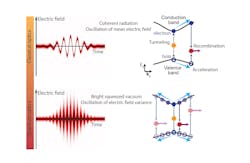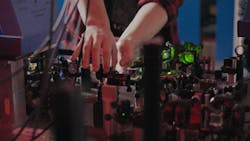Bright squeezed vacuum pulses generate high harmonics
Max Planck Institute for the Science of Light (Germany) researchers led by Maria Chekhova, whose group focuses on quantum radiation, and Francesco Tani, whose group explores ultrafast and twisted photonics, in collaboration with Denis Seletskiy from Polytechnique Montreal (Canada) and researchers from Technion (Israel), recently combined forces to explore generating high harmonics via different kinds of light (noncoherent photon statistics).
Based on their previous work, they anticipated new and interesting observations and expected pulses of bright quantum light, a.k.a. “bright squeezed vacuum,” could be a good way to enhance multiphoton effects (see video).
Inspiration
In 2023, colleagues at Technion reported theoretical work to generate nonperturbative high harmonics within gaseous media—the main route to generate coherent pulses within the extreme ultraviolet and x-ray spectral regions with durations as short as a few tens of attoseconds—by quantum light and predicted the spectral coverage of high-harmonics sources can be significantly extended.1
“Other researchers simultaneously started exploring the quantum aspects of high-harmonic generation.2 It further motivated us, so we combined our expertise in quantum optics and ultrafast nonlinear optics to start exploring the generation of high harmonics using bright squeezed vacuum pulses,” says Tani.
Squeezed vacuum
What’s a squeezed vacuum? Light is an electromagnetic wave that propagates in space and oscillates in time at a certain amplitude. Even when the amplitude is zero, according to quantum physics, it still exhibits small fluctuations known as “zero-point field or vacuum fluctuations.” Think of them as random faint ripples on water’s surface.
“Using strong laser pulses, we can periodically enhance and suppress these vacuum fluctuations within a nonlinear crystal to generate a quantum state of light—a squeezed vacuum,” explains Tani. “By optimizing this process, we can obtain very bright squeezed vacuum states with mean photon numbers sufficiently high to drive highly nonlinear processes within a material and even ionize it.”
High-harmonic generation
High-harmonic generation (HHG) is a nonlinear process in which intense ultrashort pulses of light interact with matter—and it drives electrons to emit high harmonics of the driving field frequency. When the intensity of the light is sufficiently high, it drives the electrons far away from their initial state and their dynamic is no longer a small perturbation.
These nonperturbative dynamics can “alter the generation of high harmonics, enable encoding information within them, and result in multiple harmonics—even within spectral regions beyond the absorption edge of the material and lead to unique sources of radiation,” says Tani.
Nonperturbative high harmonics is the foundation of attosecond science and creates unique sources of ultrashort pulses within the extreme ultraviolet and x-ray spectral regions. “This process has been accessed only by classical coherent light, but with our work we show for the first time that we can access it with quantum states of light,” Tani adds. “And because of its peculiar properties, we think it’s very exciting and promises access to completely new regimes and applications.”
Bright squeezed vacuum pulses
A bright squeezed vacuum (BSV) provides simultaneous access to both the perturbative and nonperturbative regimes, and it also speeds up data acquisition. “With coherent light, observing the transition from the perturbative to the nonperturbative regime means we need to acquire the harmonics yields as a function of the pump power, which can be a time-consuming process,” says Tani. “On the other hand, BSV contains all possible intensities and the acquisition time is considerably reduced.”
One of the most interesting aspects of this work for the team was finding a common language in a scientific sense to describe the two combined research areas—ultrafast nonlinear optics and quantum optics—and understand each other,” says Tani. “Both fields involve photons, but the approaches are very different. Working together and combining these research areas was very interesting and it really opened our minds.”
When Andrei Rasputnyi, a Ph.D. student working with Chekhova and Tani, generated a few tens-of-femtosecond-BSV pulse with microjoule-level energies (corresponding to peak powers order of magnitudes larger than previously reported) in the lab for the first time, the team realized it meant they could access new and unexplored regimes, and similarly when he generated high harmonics for the first time via BSV.
Most important lab equipment for this work? “An old Ti:Sa laser amplifier to deliver ~40-femtosecond pulses with millijoule-level energy, but other types of femtosecond lasers may also be used for this purpose,” says Tani. “The rest of our equipment is pretty standard: Nonlinear crystals, photodiodes, a CCD-based spectrometer, and various optical elements.”
Biggest challenge? Identifying ways to fully exploit the quantum aspects of a BSV, which isn’t straightforward because it’s very susceptible to any imperfections of the optical mirrors and lenses—even dust can lead to scattering and reduce quantum squeezing.
“On short timescales, generating high harmonics using bright squeezed vacuum pulses can provide a valid route to probe the properties of matter using high-intensity light with a reduced probability of damaging the sample under study,” says Tani. “In the long run, we believe it will provide a new tool for exploring the quantum properties of matter, as well as enable coupling of quantum light and quantum matter to engineer quantum states within the ultraviolet and x-ray spectral regions.”
What’s next?
There’s a long list of experiments Tani and Chekhova want to try, but they’ve narrowed it down to three. First, they want to try to experimentally observe quantum light increase the number of high harmonics and extend its spectral coverage (the cutoff) as predicted by Alexey Gorlach (Technion) and colleagues in 2023.
Next, they’d like to demonstrate that BSV pulses can generate high harmonics from gaseous media to generate extreme ultraviolet radiation.
“These two experiments will provide a route to validate further and adapt the theoretical models used to describe the interaction of nonclassical light with matter in the nonperturbative regime and may provide a promising route to extend the spectral coverage of tabletop sources of ultrashort XUV and x-ray radiation,” says Tani.
And they also want to try to use BSV pulses to drive, study, and maybe even control the dynamics of electrons within matter.
FURTHER READING
A. Rasputnyi et al., Nat. Phys. (2024); https://doi.org/10.1038/s41567-024-02659-x.
REFERENCES
- A. Gorlach et al., Nat. Phys., 19, 1689–1696 (2023); https://doi.org/10.1038/s41567-023-02127-y.
- M. Lewenstein et al., Nat. Phys., 17, 1104–1108 (2021); https://doi.org/10.1038/s41567-021-01317-w.
About the Author
Sally Cole Johnson
Editor in Chief
Sally Cole Johnson, Laser Focus World’s editor in chief, is a science and technology journalist who specializes in physics and semiconductors.


